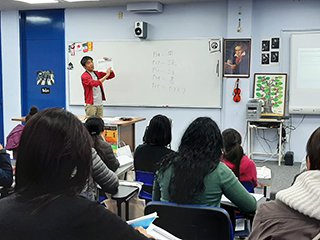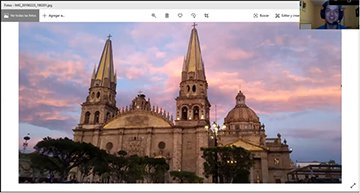Japanese-Language Education in Mexico Is Heating Up
The Japan Foundation, Mexico
SATO Goro and UKAI Kanako
The Japan Foundation, Mexico (hereinafter "JF Mexico") has dispatched one Japanese-Language Senior Specialist and two Japanese-Language Specialists to support Japanese-language education in Mexico and in the Caribbean region of Central America, and, in this report, we will primarily introduce our support for Japanese-language education in Mexico.
1. The Connection Between Japanese-Language Education in Primary and Secondary Educational Institutions
In FY2018, a once every three years Survey on Japanese-Language Education Abroad was conducted by the Japan Foundation, and it brought to light the expansion of Japanese-language education at the primary and secondary education levels. However, at these levels the Japanese language is not a regular subject and there is no national curriculum, so the actual state of affairs is that teachers in the field have been working without proper guidance. Therefore, in FY2019, JF Mexico decided to focus on supporting primary and secondary Japanese-language education, and, in order to further enhance Japanese-language education at these levels and to attract interest from more people, JF Mexico planned and implemented the following series of projects. In implementing them, JF Mexico cooperated with domestic primary and secondary educational institutions.
November 2019: 23rd Primary/Junior High School/High School Japanese-Language Presentation Conference: Special Seminar on "Considering Japanese-Language Education in Primary and Secondary Educational Institutions"
December 2019: Japanese-language teacher training program for primary educational institutions in Mexico
February 2020: Japanese-language camp in Mexico
Here, we will briefly introduce the teacher training program for primary educational institutions in Mexico. This training is conducted under the theme of "creating syllabuses and teaching materials in primary education," and the participants were 32 teachers from three schools (two private schools and one private language school) that provide Japanese-language education for primary school students. A Japanese-Language Senior Specialist served as the lecturer, and, teachers talked about the points to keep in mind when creating syllabuses for primary school students, teaching materials, and available resources, etc., while sharing their own experience in creating textbooks. In the latter half of the training, each group decided a theme, created a syllabus and simple teaching materials, and then presented them. Despite only having a short 90 minutes, all of the groups appeared to put the advice to practical use and immediately produced well-thought out and impressive results. Afterwards, the training was an opportunity for the teachers at each school to work together on creating new syllabuses and teaching materials, and, additionally, it also seems that they were exchanging information between schools. As the people who put on the training, we were so thankful and glad to see these teachers put into practice the things they learned in the training and then create exchanges between each other. We are planning a second teacher training program for primary educational institutions in December 2020, and we want to further help the development of primary and secondary school Japanese-language education.

Japanese-language teacher training program for primary educational institutions
2. Worldwide, the Most Registered Individuals for the "JF Japanese e-learning Minato" Online Japanese e-Learning Platform
In 2016, the Japan Foundation Japanese-Language Institute, Kansai launched the "JF Japanese e-learning Minato" (hereinafter "Minato") Japanese-language learning platform for studying the Japanese language in order to provide people all over the world with the opportunity to learn Japanese, including for "Learners who cannot attend Japanese-language classes due to geographical or time constraints" and people who "want to start learning the Japanese language from now on." About four years after "Minato" was launched, JF Mexico has been conducting a variety of public relations activities, both online and offline, in order to provide everyone with a Spanish-language version of "Minato" so that they can learn the Japanese language in Spanish, and, as of the end of June 2020, there were 31,658 "Minato" registrants from Mexico, which is the most from any country in the world.

Learners presenting their own town in a live lesson while showing photos they took
There are a variety of courses in "Minato," and JF Mexico holds "'Marugoto: Japanese Language and Culture' Tutor Support Course." As course operators, Japanese-Language Specialists are in charge of public relations for the courses, managing and supporting learners, and giving advice to the instructors in charge of lessons. The courses are also run with the goal of "creating an environment where students can comfortably learn and where instructors can comfortably teach." For example, in a live-streamed lesson, the instructor will be in charge of the lesson and the Japanese-Language Specialists will provide support to the instructor and students behind the scenes. There are countless things unique to online classes that can occur, such as the teacher suddenly disappearing due to a power outage during the class or students who can't get home due to traffic jams so they park their car on the side of the road and take the class there, etc., but the Japanese-Language Specialists handle these issues so that the classes can proceed without problems. After the course, the students also often say things like "In my life, I never thought that I would be able to study the Japanese language with a teacher and with classmates" and "I want to continue studying the Japanese language in the future."
Mexico is approximately five times larger than Japan in terms of area, and not all regions have Japanese-language schools. Unfortunately, there are also some regions where it is difficult to attend a language school because of security problems. On the other hand, amidst the various kinds of impacts to our lives from COVID-19, learners were able to continue learning the Japanese language on a daily basis because there is an online course, and this reaffirmed the strengths of online learning.
JF Mexico will continue to provide learners in Mexico, Central America and the Caribbean region with online learning opportunities and will support Japanese-language learning in various ways. As one of these efforts, we are currently producing a "Minato" course for "Japanese Language for beginners through business (A2)."
Note: The number of Japanese-language learners at primary educational level: 775 in FY2015 → 1,081 in FY2018; the number of Japanese-language learners at secondary educational level: 863 in FY2015 → 1,115 in FY2018.
- What We Do Top
- Arts and Cultural Exchange [Culture]
- Japanese-Language Education Overseas [Language]
- Japanese-Language Education Overseas [Language] Top
- Learn Japanese-language
- Teach Japanese-language
- Take Japanese-Language Test
- Know about Japanese-language education abroad
- The Japanese-Language Institute, Urawa
- The Japanese-Language Institute, Kansai
- Japanese-Language Programs for Foreign Specified Skilled Worker Candidates
- Japanese Language Education for Japanese Children Resident Overseas and for the Descendants of Migrants
- Archives
- Japanese Studies and Global Partnerships [Dialogue]
- JF digital collection
- Other Programs / Programs to Commemorate Exchange Year
- Awards and Prizes
- Publications
